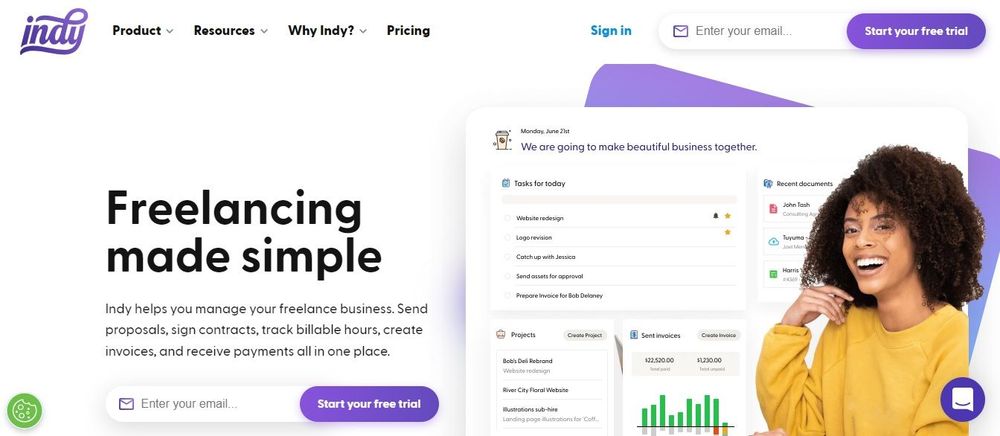No matter their size, all businesses that want to be noticed need a marketing strategy. If you are a freelancer or just getting started with your company, a marketing plan is essential, as it can get your products and services out there faster.
You might be a little unsure about where to begin with your marketing strategy. Many people choose to use a marketing plan template because it gives them a shortcut to a set of documents that would otherwise require a lot of time and effort to complete. There's absolutely nothing wrong with using such a template - quite the opposite, really. If something is proven to work, why reinvent the wheel?
In this article, we have gathered some of the best strategies and examples to help you create a comprehensive marketing plan for your freelance business or small company. We will also show a complete marketing plan template that you can adapt to your needs and already has all the essential elements to launch your first campaign.
Without further ado, let's look into what makes a marketing plan great and how yours can make a difference for your company.
What is a marketing plan?
A marketing plan is basically an operational document. It outlines a strategy for running advertising to reach a specific market or to generate new leads. A marketing plan usually includes all the campaigns (social media, SEO optimization, email, word of mouth, etc.) you intend to run to achieve a particular goal and how you will measure their success once completed.
A good marketing plan is always supported by market research and accurate pricing decisions. It should also identify your brand's value proposition and list all the channels you intend to use to reach your marketing goals.
Many people use a marketing plan template to start planning their strategy. This is a great way to launch yours too, but keep in mind that you should always adjust your marketing efforts on an ongoing basis - especially after you've acquired new metrics.
A marketing plan vs. a business plan: what’s the difference?
There are some similarities between a marketing plan and a business plan and some significant differences, so you shouldn't use the terms interchangeably.
A business plan details how your business will operate. It's a sort of roadmap for your company. It states missions, values, goals, financials, and all the strategies you will use while running your operations.

A marketing plan, on the other hand, is one of the parts of a business strategy. It focuses primarily on how you're going to bring awareness of or attention to your brand, its products, and services. It usually specifies in detail how you're going to reach a target market or generate sales.
Before you pick a marketing plan template...
There is one thing you should consider doing before looking for an example of a marketing plan to use as your template- and that's conducting a situation analysis. It doesn't need to be a complex process. In fact, if you're a freelancer or have a new business, it might be enough to just think carefully about it and take some notes.
One thing is certain, however: A marketing plan template will be of particular help if you're familiar with your target market and target audience and understand your own weaknesses and strengths well.
In addition to surveying the panorama, you can also look at your competitors and compare your products and services. What are they missing that you have? What could you do better? Answering questions like these can help you determine what your customers want and support your marketing strategy efforts.
The different parts of a marketing plan
An effective marketing plan will vary slightly depending on your type of business (for example, B2B or B2C) and your digital presence. However, there are some elements that all marketing plans have in common.
These include:
- The business summary: This is a section including the most relevant information about your company. For example, your business name, where your offices are located, your mission statement, and sometimes your team members and any relevant stories about your company's founding.
- The marketing initiatives: The collection of goals for your marketing strategy. This section is somewhat similar to the one you would find in a business plan (usually called business initiatives). Still, it should instead focus on specific marketing projects, such as increasing your website's Google rank or launching a new blog.
- The customer analysis: This element of the marketing plan describes your industry (and sub-industries) and the most important characteristics of your buyers. For example, their age, location, goals, challenges, and triggering events. Many marketing plans present this information using client personas.
- The SWOT analysis: Many plans include a SWOT analysis section listing the strengths, weaknesses, opportunities, and threats of your business. Basically, what you're good at, what you want to fix, your differentiators, and things that could hinder your marketing strategy.
- The competitor analysis: It's unlikely your product or service will be completely unique. The competitor analysis section should include products and companies you compete with, their offerings, market share, positioning, and pricing.
- The marketing strategy itself: This section would be a primary account of how you will approach the market. For example, the characteristics that make your products unique, why your price is competitive, or in which ways you have or plan to promote them. You can also include a description of your marketing team if you have one, and the role they will play in your overall strategy.
- The marketing channels: A list of all the marketing channels you intend to use to promote your products or services and the metrics you will employ to measure the success of your campaigns. For example, if you utilize a social network to promote brand awareness, you might count page views per month to see how well your promotion worked.
- The budget: This section should list the amount of money you have allocated to pursue your marketing strategy. It's best to atomize your elements and explain the different expenses and estimated prices. This section will also typically include outsourcing costs, software, events, and paid promotions.
- The financial projection: In some cases, a marketing plan also includes the total budget for your marketing efforts and the expected ROI. You can also mention your financial projections for the year.
The target audience for a marketing plan and strategy
We have now gone through the different parts of a marketing plan - but what's actually the target audience for it? In many cases, you write a marketing plan as part of your business strategy. These documents can come in handy when you need to raise capital, but they are also quite valuable for customers, employees, and stakeholders.
If you are a solopreneur or independent freelancer, the best outcome of your marketing plan will be clarity. By writing down your goals, you will be able to see all the different ways in which you can grow your business and have more precise objectives for your campaigns.
It's essential to know your own marketing plan well (even if you don't have a marketing department) as it's a cache of valuable information and can help you clarify your unique selling position.
Why your marketing strategy matters
Setting up marketing objectives and coming up with a comprehensive marketing plan can help you determine who your audience is and how to reach it best. It can also help you establish your prices and define how you will measure your company's efforts.
You should continuously monitor and adjust your marketing strategies. However, whether you are starting a business or exploring ways to explore one you already have, a marketing plan will always be your best companion for growing your company and increasing your sales.

Should you use a marketing plan template?
The short answer is: Sure! There are several advantages to using a marketing plan template instead of writing one entirely from scratch. The main one is that you will already have all sections of it pre-drawn, and all you will need to do is add in your specific information. In addition, having a solid outline will save you time and help you organize all your data in a way that is proven to work (as more people are familiar with its structure).
Your marketing plan is a high-level view of all your marketing strategies and how they can help you reach your business objectives. Creating one from zero takes time, so most businesses and freelancers choose to use marketing plan examples and templates that already contain all the crucial questions.
What makes a marketing plan template good?
The goal of a marketing plan template is, ultimately, to help you create your marketing strategy in a way that your team can easily understand. If you follow a comprehensible template, your plan should include all tasks and projects, campaigns, events, and marketing budgets all in one place.
The best marketing plan examples are those that can cover the efforts of at least an entire year (although some companies will prefer to break them down on a quarterly or bi-annual basis). The document itself doesn't need to be long, however. A one-page template can include all the relevant strategic decisions and make it easier to align different teams.
What matters the most is that you cover all the relevant elements. So let us show you what we feel are the mandatory components of a marketing plan and show you some examples of what to include.
Our ultimate marketing plan template
As we mentioned, working with marketing plan examples can save you significant time and effort. You can find a random free template online, but you should always make sure you are using the best quality templates to create your marketing strategy. It is, after all, an important part of your business strategy as a whole.
We have put together a marketing plan template that should cover all your business needs - especially if you are a small company or freelancer. So let's look at the different parts of the marketing plan and what you can include in each.
The business summary
It is best to open your marketing plan with a business summary or an overview of who you are and what you do - particularly, what you do best and why. This section is basically a summary of your organization. It should be short but include any relevant information that makes your business stand out from the competition.
The business summary part of your marketing plan should include:
- The name of your company
- The location of your offices or operations (if you have more than two, you can list the most important ones)
- Your company's mission (or mission statement)
- Any noteworthy achievements (such as awards or accomplishments)
- Your marketing team and leaders (including, for example, the name, job title, and a brief description of their responsibilities)
For example:
[Your Business' Name] is a company headquartered in [Your location] (with offices in [any other locations from where you operate]). Our mission is to [mission statement]. Our marketing team is composed of:
- [Marketing team member 1's name], [person's job title]. They [Description of main activities and responsibilities].
- [Marketing team member 2's name], [person's job title]. They [Description of main activities and responsibilities]...

The marketing initiatives
This section of your marketing plan should focus on the different goals you want to achieve by running your marketing campaigns. Usually, marketing strategies and business strategies are similar - but you should try not to include the big-picture you have in mind for your company here. The focus should instead be on your detailed marketing plan and marketing tactics.
The best thing you can include in your marketing initiatives section is the different projects you will implement specific to marketing. For example:
- Your company's overarching goals
- How the marketing team will pursue any marketing initiatives
- The initiatives themselves, including:
- The description
- The main goals
- The metrics you will use to measure success
For example:
[Your Business' Name] has the goal of [Your main goal]. To help us achieve this goal, we will pursue the following activities:
- [Maketing Initiative 1]: Over the next [Period of time, for example, "12 months"], we will work on [Description of the activity. For example, launching a blog]. The goal of this initiative is to [Description of all goals related to initiative 1. For example, to increase Google rank and generate content for the sales team]. We will measure its success by [Description of success metrics. For example, reaching a certain number of organic page views per month].
- [Marketing Initiative 2]: [Same as Initiative 1]...
The customer analysis
Before completing this section, you should conduct your thorough market research. If you have already done it, then you can explain it here. The customer analysis part of a marketing plan aims to describe the industry you're targeting and who your prospective buyers are. After all, it's always helpful to understand what other people think about your company.
Many marketing campaign planners use buyer personas to plan their strategy better. A persona is a fictional description of a buyer, and you usually prepare a few different ones depending on the components of your audience. They typically include demographic information like age and gender, traits like goals, pains, personal challenges, and the triggers that push them to interact with a particular product or service.
For example:
We are targeting the following industries for the year [Year]:
- [Industry 1]: Including [Related industries where you intend to sell your products or services].
- [Industry 2]: Including [Related industries where you intend to sell your products or services]...
The SWOT analysis
Most marketing plans include a SWOT analysis to highlight your business's strengths, weaknesses, opportunities, and threats. You can write most of this section using your existing (or new) market research. The first time you approach your SWOT, you might feel a little discouraged by the amount of information you need to process. However, having this analysis will come in handy for all stages of your business, and it's something valuable to have in your toolbox.
You can list your SWOT investigation in a table. As a quick refresher, SWOT refers to a strategic management technique, also known sometimes as a situational assessment or situational analysis. The matrix is composed of four parts:
- Strengths: What do you do well? What are your unique resources?
- Weaknesses: What could you improve? What resources do you lack?
- Opportunities: What trends or opportunities are open to you? How can you take advantage of them?
- Threats: What things could harm your business? Can your competition challenge you?
For example:
At [Company name], we want to help our brand focus on what it does best ([Your main strengths]), improve what we can ([Main weaknesses]), capitalize on new opportunities ([Your main opportunities]), and defend against any potential challenges ([Your main threats]). Here is our SWOT analysis for [Year]:
- Strengths: [List 3-5 of your main strengths]
- Weaknesses: [List 3-5 of your main weaknesses]
- Opportunities: [List 3-5 of your main opportunities]
- Threats: [List 3-5 of your main threats]

The competitor analysis
When you launch a new company, product, or service, you should always make sure you research who your competition is - primarily, so you can identify any gaps in the market and take advantage of a unique selling proposition. In addition, it's important to analyze not just what your competitors offer but what things they do well and where they fail at.
You can learn more about your competitors by reviewing their websites and any related news coverage of these other companies. You can also check a site's rank and performance and categorize them from least to most competitive. Other things to include in your competitor analysis marketing plan may include:
- Your competitor's market share
- Their offerings
- Their general positioning
- The pricing of their products and services
- Their site's authority score
- Their main ranking keywords
For example:
We expect to compete with the following companies within our target market(s):
- [Company 1]: [Company 1] produces [List of the competition's relevant products or services, what they do, and how they might be better than what you are offering].
- [Company 2]: [Same as Company 1]...
The marketing strategy itself
It's now time to explain how you will use all the information from your research and competitive analysis to plan your marketing strategy and how you will approach the market.
A good marketing plan will include what is typically called "the seven Ps of marketing" (product, price, place, promotion, people, process, and physical evidence). In particular, the main things to consider for this section are:
- What your company is going to offer that is special and competitive
- The price of your products
- The ways in which you're going to promote them
- The promotion process
- Any evidence to supplement your plan
- The main social media channels you will use (don't go into too much detail as we'll cover these in the next section).
For example:
Our marketing strategy is as follows:
- Product: Our main product is [Describe your products. Include how it solves a particular problem or challenge - especially one you have mentioned in your customer analysis - and what makes it different from your competitors]
- Price: We will sell our [Product/s] for [Price]. Our reasoning is that [Explain why you have reached a price suggestion, how it links to your customers' budget, etc.]
- Promotion: We will promote our [Product] by [Explain your promotion means].
- [Repeat for the remaining marketing Ps]
The marketing channels
It's always important to list the marketing channels you will use to promote your products and services. Your marketing plan should mention which social networks you plan to utilize and why you have chosen them - so the advantages of each marketing campaign type are clear for everyone involved.
Some common marketing channels used by businesses and freelancers include:
- Social media marketing
- Search engine optimization (SEO)
- Email marketing
- Word of mouth (WOMM)
- Influencer marketing
- Offline advertising
For example:
We will use the following marketing channels to promote our [Brand or product]:
- [Marketing channel 1]: The purpose of this channel is to [Purpose. For example, brand awareness]. We will measure the success by using [Success metric. For example, 20,000 unique monthly page views].
- [Marketing channel 2]: [Same as Marketing channel 1]...

The budget
The budget part of your marketing plan refers to the amount of money you will invest in marketing efforts. For example, for a social media marketing campaign, content marketing strategies, etc. It shouldn't be confused with your product's price or any other financials concerning your company.
You should explain the budget you have allotted to the marketing team to pursue different goals and initiatives in an itemized way. You should include numbers relevant to your campaigns too. Some things this section usually includes are:
- Marketing software you might use
- Paid advertisements
- Events that might attend or host to promote your products
- Any relevant outsourcing costs for other providers or agencies
For example:
Over the course of the year [Year], given the allotted cash for the marketing team, we will invest in the following items:
- [Marketing expense 1]: [Expense name]. [Estimated price].
- [Same for Marketing expenses 2, 3, etc...]
- Total: [Total estimated price for all items, for the listed year]
The financial projection
You can exclude this section from your marketing plan if you want to, but many freelancers and small businesses prefer to add a small financial projection at the end of their document.
Having one can leave investors and stakeholders with a positive impression as you can demonstrate how your research and budget estimations lead you to an expected ROI.
For example:
We estimate a financial projection of [Amount] for the year [Year].
Using Indy for your marketing strategies

Indy is a one-stop shop for all your marketing and business needs. Our platform is ideal for small businesses and freelancers looking to simplify their day-to-day work. We can also help you write and distribute your marketing plan.
Some of the tools in our platform that you should check if you're launching a marketing strategy include:
- Calendar: To schedule marketing campaigns and meetings and keep tabs on your marketing efforts. We offer day, week, and month views and integrations with all of our other powerful tools.
- Contracts: You can use one of our legally-sound contract templates to work with outsourcers and other marketing contractors, agencies, etc. We also support e-signatures.
- Files: Ideal for sharing campaign ideas, images, videos, audio, etc. We have version control and can track all revisions, feedback, and approvals.
- Invoices: Easily create and send invoices and get paid faster than ever for all your marketing efforts.
- Proposals: Perfect for working more efficiently with clients and other contractors. Our easy-to-create proposals and estimates are engaging and fully trackable through the dashboard.
- Tasks: Keep track of all your campaigns and projects with our simple but powerful task management app. Get a clear picture of what's ahead and connect everything with your calendar.
- Time Tracker: Record all your activities, create automatic invoices, and get quickly paid for all your efforts.
We have helped countless freelance businesses manage all aspects of their company. Don't let your marketing strategy overwhelm you. You can try Indy for free and gain access to nine tools, all from one place.



